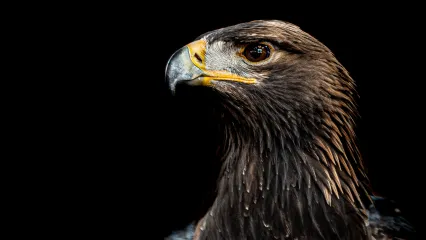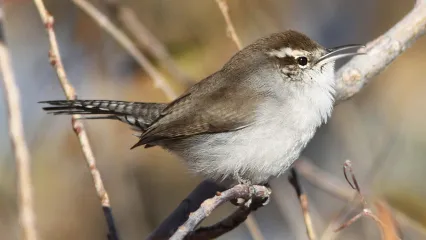
Description
The golden eagle (Aquila chrysaetos) is a raptor that ranges over mountains and grasslands of primarily the western United States. These majestic birds may occasionally be spotted riding air currents and gliding with wings stretched wide while wintering in Oklahoma.
Golden eagles were given their name because of their golden-brown feathers on their head and necks. As adults, coloration is an easy way to tell them apart from the more famous bald eagle. However, the juveniles of both birds can be easily confused. The easiest way to tell young golden eagles from bald eagles is to look for a band of white along the golden eagle's tail feathers.
The majority of their diet consists of jackrabbits, prairie dogs, cottontails, ground squirrels and rats. They will occasionally feed on snakes, large birds and opossums. During winter, they take on the ecological role of the vulture by scavenging for food such as road-killed raccoons and deer.
These birds have a long history involving people. Early man was known to paint pictures of eagles on cave walls. In Native American stories, eagles were responsible for thunder and lighting. Roman soldiers carried eagle statuettes to war atop their battle standards. Later, eagles were associated with royal falconers, and only emperors and kings were allowed to use them to hunt. While golden eagles aren't considered threatened, their population has declined in the past century. Still, the federal Eagle Protection Act provides these birds with total legal protection.
Size
These large birds are 2 feet tall when sitting and have a wingspan of 8 feet, and they can easily soar at 45 mph.
Habitat
Golden eagles occur in Oklahoma in two groups. One group lives year-round in Cimarron County. It's not always easy to spot them since they roam large territories that can easily encompass more than 20 square miles. This small population nests in Oklahoma, averaging three to six pairs annually over the past several decades. The second group, about 100 eagles, migrates into Oklahoma each winter from the Rocky Mountains. The migrant eagles mainly stay west on Interstate 35, although sightings have been documented in every county of the state over the years. These migrants do not nest in Oklahoma.
Life Cycle
These birds mate for life, and pairs begin preparing to nest months in advance. Male and female golden eagles work together to repair old nests and building new ones during summer and through the fall. Nests are usually on cliff faces or in cottonwood trees. The heavy-duty nests can be from 6 to 8 feet across and remain for years at a time. In spring, the birds choose a nest and line it with fresh greenery, then the female lays its eggs.
Usually two to four eggs are laid. They begin to hatch about a month later in the same order in which they were laid. This gives the firstborn eagle an advantage over its siblings because it has more time to eat and grow. It is not uncommon for the later-hatched eagles to die of starvation just because they cannot compete with the nestlings that were born only one or two days earlier.
Male eagles will bring food to the nest two to three times per day so that the female can rip it into smaller shreds to feed the eaglets. At 3 weeks old, the eaglets can stand. At 6 weeks, they can begin to feed themselves on the food that is left in the nest by the parent birds. At 9 to 10 weeks old, the young birds are ready to leave the nest. easily encompass more than 20 square miles. This small population nests in Oklahoma, averaging three to six pairs annually over the past several They remain in the area, close to their parents, to learn how to hunt. When they strike, they fold in their wings and dive straight down on their prey at speeds that can exceed 120 mph. Golden eagles are excellent hunters. They can grow to weigh 14 pounds, hunt on the wing and use their outstanding eyesight to spot prey. When they strike, they fold in their wings and dive straight down on their prey at speeds that can exceed 120 mph. When close to their prey, they will unfold their wings and thrust their talons outward to deliver a killing blow with the full force of their dive behind them.


